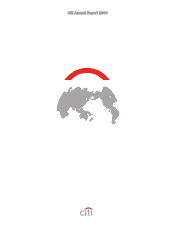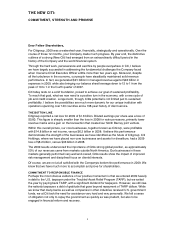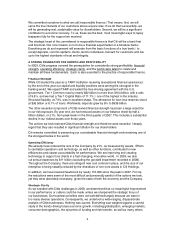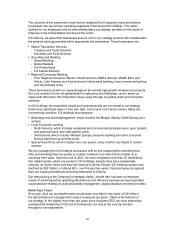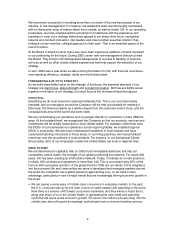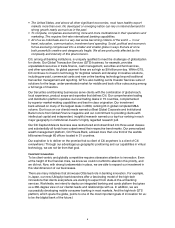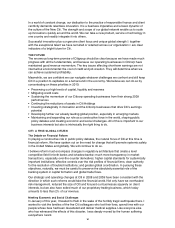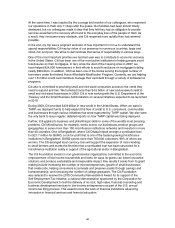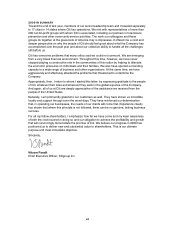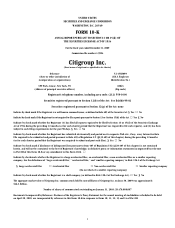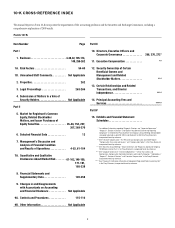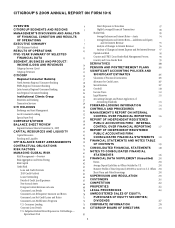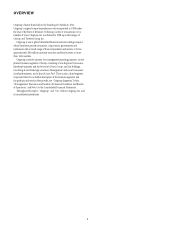Citibank 2009 Annual Report Download - page 4
Download and view the complete annual report
Please find page 4 of the 2009 Citibank annual report below. You can navigate through the pages in the report by either clicking on the pages listed below, or by using the keyword search tool below to find specific information within the annual report.
ii
We committed ourselves to what we call “responsible finance.” That means, first, we will
serve the true interests of our customers above anyone else. If we do that successfully, we
will be generating real, sustainable value for shareholders. Second, we will be a significant
contributor to economic recovery. To us, these are the best, most meaningful ways to repay
taxpayers fully for the support we received.
The strategic heart of the commitment to responsible finance is that Citi will be a bank first
and foremost. Our core mission is not to be a financial supermarket or a “shadow bank.”
Everything we do and represent will emanate from the basic functions of a true bank – to
accept deposits, commit capital to clients, lend to individuals, transact for customers and live
up to the highest standards of trust and integrity.
A STRONG FOUNDATION FOR GROWTH AND PROFITABILITY
In 2009, Citi’s progress covered the prerequisites for consistently strong profitability: financial
strength, operating efficiency, strategic clarity, and the world-class talent to create and
maintain all these fundamentals. Each is also essential to the practice of responsible finance.
Financial Strength
While Citi started the year as a TARP institution receiving “exceptional financial assistance,”
by the end of the year our capital and liquidity positions were among the strongest in the
banking world. We repaid TARP and exited the loss-sharing agreement with the U.S.
government. Tier 1 Common rose by nearly $82 billion to more than $104 billion, with a ratio
of 9.6%, and we had a Tier 1 Capital Ratio of 11.7% – one of the highest in the industry.
Structural liquidity, at 73%, was in excellent shape. The allowance for loan loss reserves stood
at $36 billion or 6.1% of loans. Worldwide, deposits grew by 8% to $836 billion.
The other essential component of Citi’s revived financial strength has been a large reduction
in our risk exposure. By year end, we had reduced assets on our balance sheet by half a
trillion dollars, or 21%, from peak levels in the third quarter of 2007. This includes a substantial
decline in our riskiest assets over those years.
The actions we took restored Citi’s financial strength and therefore were essential. I deeply
regret that they also resulted in significant dilution for our shareholders.
Citi remains committed to preserving our considerable financial strength and remaining one of
the strongest banks in the world.
Operating Efficiency
We already have reduced the size of the Company by 21%, as measured by assets. Efforts
to centralize operations and technology, as well as other functions, contributed to new
efficiencies and clearer accountability for performance. We are improving and creating
technology to support our clients in a fast-changing, innovative world. In 2009, we also
cut annual expenses by $11 billion (excluding the goodwill impairment recorded in 2008).
Throughout the Company, there are stringent new cost controls in place, and the size of our
enterprise is being steadily reduced by the divestiture of non-core assets in Citi Holdings.
In addition, we have lowered headcount by nearly 110,000 since the peak in 2007. For me,
the reductions were some of the most difficult and personally painful of the actions we took,
yet they were absolutely necessary, given the state of both the economy and the Company.
Strategic Clarity
As we wrestled with Citi’s challenges in 2008, we determined that no meaningful improvement
in our performance or culture could be made unless we sharpened the strategic focus of
our businesses. Our business priorities were not well-defined largely because we were in
too many diverse operations. Consequently, we undertook a wide-ranging, dispassionate
analysis of Citi’s businesses. Nothing was sacred. Everything was weighed against a careful
study of the trends driving future economic growth, including globalization, emerging markets,
consumer demographics, the dynamics of funding and risk transfer, as well as many others.

